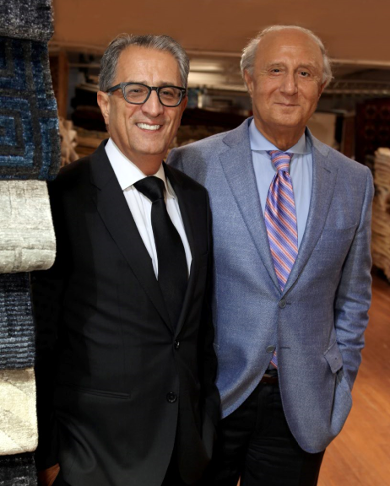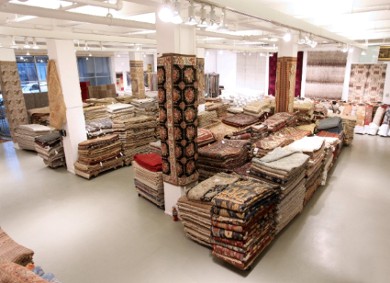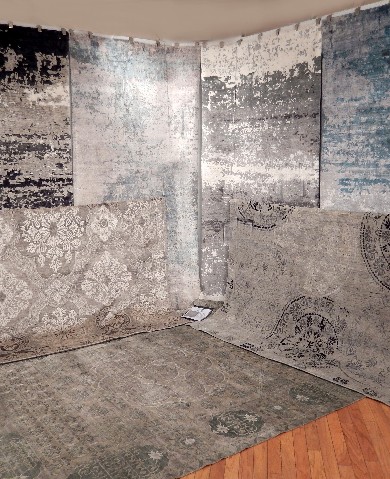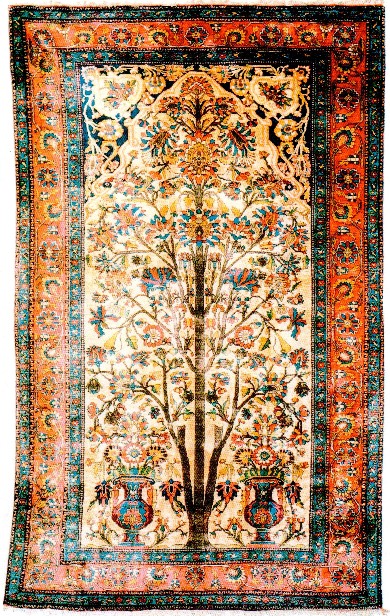NEW YORK -- A quiet metamorphosis has been underway for several seasons at Harounian Rugs International (HRI) as the company fine-tunes its strategy targeting interior designers and upscale retailers, and unveils a glamorous look at a string of new showrooms in New York, Atlanta, Las Vegas and later this month in High Point.
At the spring 2017 New York Home Fashions Market, Mar. 26-29, 2017, RugNews.com toured HRI's new Manhattan headquarters, opened in December 2016, and spoke with founder David Harounian about the company's unique niche and staying power as a designer source for fashion and on-trend color.

Brothers Lee and David Harounian, who jointly run Harounian Rugs International, will open their fourth new showroom in two years at this month's High Point Market.
In this exclusive interview, Harounian reflect on changes in the industry since HRI opened its doors in the once-thriving New York City Rug District, and the developments that catapulted the company to double digit sales growth over the past three years.
HRI was one of the last holdouts in the Rug District in New York City. What prompted the move?
DAVID HAROUNIAN: The Rug District has virtually disappeared. It's a completely different landscape from when I started dealing in antique rugs in 1964. Rug dealers who once dominated the area have either gone out of business or moved to smaller warehouses and offices in New Jersey or Long Island. None of the major rug dealers are in the neighborhood now.

A first look at HRI's new Manhattan showroom and corporate headquarters, an expansive ground floor and second-story wrap around space at 104 West 29th Street.
Why did you stay so close to the old neighborhood?
DH: For over 50 years, we've had just two addresses: 245 Fifth Avenue and 261 Fifth Avenue, where we've been for the past 15 years. Like so many commercial buildings, 261 Fifth is changing to residential. That's why we moved. We're now a bit further west. But this neighborhood south of Herald Square is blossoming with rug companies: Obeetee and Orian moved within blocks of us last year as well.
We decided to stay in Manhattan to continue long held relationships with major New York City design firms, but to also be convenient to key customers who attend the textile markets. We also needed more space to accommodate the sales growth we've been fortunate to be experiencing over the past few years.
HRI's showroom expansion program began in 2015 with a move to an impressive new space on the 5th floor in AmericasMart Building 1, where the company showed its updated traditional designs in pale fashion colors.
What's the secret to HRI's double-digit growth -- it's been steady for the past several years, right?
DH: Our success has only been achieved due to our sales management staff and loyal customer base established through the years. We had a double-digit increase for 2016, following the strong sales growth trend we've been experiencing since 2013. In that time we have invested in our sales force, in product development, and with new and larger showrooms in all of the markets our customers shop. Our private label program has seen great growth. We use our experience and strong ties to design and manufacturer a wide array of qualities for many retail chains.
A luxurious new Sensation collection wool and silk rug previewed at New York Home Fashions Market will be on view at HRI's new showroom during spring High Point Market.
How did HRI get its start?
DH: I started dealing in antique rugs in 1964 -- five years after I had arrived at age 18 in New York [from Iran] and had finished my college education. I soon saw a need for handmade rugs in the United States: hardly any homes I saw had Oriental rugs -- except for a chosen few. I began importing handmade rugs, primarily from Iran. Like any beginning business, it was difficult to get established, but within a few years we were one of a handful of major importers in the United States.
A best-selling rug from HRI's Avalon collection illustrates the shift in consumer tastes to transitional and contemporary styling.
What big changes have you seen in the rug business? The company seems to have expanded into a much broader range of items.
DH: The trends have changed. Price points have changed. The customer's wishes have changed. And, we have changed with the times. That's why we have become so diversified: Not only do we have high grade hand-mades, we also have very affordable machine-made as well as tufted rugs. That is what is required now. We even have accent rugs for New York market.
Traditional rugs are not as salable as they were a handful of years ago -- now updated traditionals and modern rugs are selling. We've been successful with traditional designs when we make them more open and use contemporary color schemes. Classic Oriental rug designs are not selling as well in hand-knotted, but they are gaining in the machine made category. It's an interesting phenomenon.
What do you consider the happiest moment of your career?
DH: What will always stand out for me was receiving the President's award in 2012 from AmericasMart and AMC. This award represents three pillars: integrity, commitment and tenacity. The award was created in 1994, and I was the third recipient. It had only been given out twice previously: once to Carl Goldberg, who worked with AmericasMart and AMC for 10 years, and then to Lucille Laufer, executive director of ORIA (Oriental Rug Importers Association).
The presenters of the President's Award described you as a selfless advocate of the rug industry and ORIA. What prompted that praise?
DH: When the award was presented, I was the longest serving president of ORIA, and very involved even before that. My brother Lee and I, through our offices in India and Pakistan, opened schools for the children of weavers to get the necessary education where there had not been proper schools, nor teachers or chairs and desks. HRI had been with Atlanta Market Center (AMC) 30 years showing at AmericasMart. During my presidency, I solicited AmericasMart and ORIA members, and together they supported organizations which had established schools in India and Pakistan for the children of rug people.
The schools in Pakistan were later stopped because of the Taliban. But then we went further and opened clinics for children's medical care. It was a collaborative effort, and between AMC and ORIA, we got this done.

HRI has adapted to fashion trends with on-point transitional collections, and led the way with its focus on best-selling blue and gray colorways.
What major challenge is facing the rug industry, and how has HRI addressed the issue?
DH: The biggest challenge is that the rug business has become a fashion industry. We change design and colors more than ever before; it is almost as though the rug has become as disposable as clothing when it comes to color and design. Consumers today are not interested so much in knot count. They want the newest color and designs.
For at least a decade we have been basing our palette on Robert Allen color forecasts. We have become known for classic designs made transitional with fashion colors, and were ahead of the trend with blues and grays. For the last couple of years we've added modern abstract designs in the same blues and grays. Many of these contemporary collections were best sellers in 2016, and continue to grow in popularity.
It is through the close ties we have developed over the past 50 years with major design firms and home furnishing fabric suppliers in the New York area that we are able to continue to be 'on trend' in color and design in all of our rugs. That's one of the key reasons we've opted to keep our headquarters in Manhattan.
What is your all-time favorite rug and why?
DH: Of course, it is a rug woven by our grandmother, Miriam Assurian, who was our mother's mother. This particular silk rug, which is signed and dated by her, is currently in the Textile Museum in Manchester, England, and it's published in a 1997 book by Anton Felton under the heading "Jewish Carpets." As to how it got to England -- that's a story for another time.

In the collection of the Textile Museum of Manchester England, a rug woven in Iran by the Harounians' grandmother Miriam Assurian, is signed and dated 1895-1899.